Estate Lookup Interiors Your Ultimate Guide to Modular Kitchen Cabinet Materials
Make the best decisions for your kitchen cabinets by learning about the optimal kitchen cabinet materials and coatings for your modular kitchen, from MDF to plywood.
An Overview of the Parts of a Modular Kitchen:
A modular kitchen comprises of separate modules that enable for simple disassembly and reassembly. These modules are constructed on-site, providing flexibility and personalization options for your kitchen space.
Explore prevalent materials and their qualities to make informed decisions for your kitchen cabinets. Whether you need office interior designers in Kolkata or top interior designers nearby, Estate Lookup Interiors offers a selection of materials to suit your requirements.
What Materials Make Up Each Module?
The base cabinet of a modular kitchen consists of top, bottom, back, and side panels that are united with micro screws and dowels to create a carcass. Shutters, fasteners, and hinges are added to the carcass, and PVC legs with adjustable height support the base modules, with skirting added to conceal the legs.

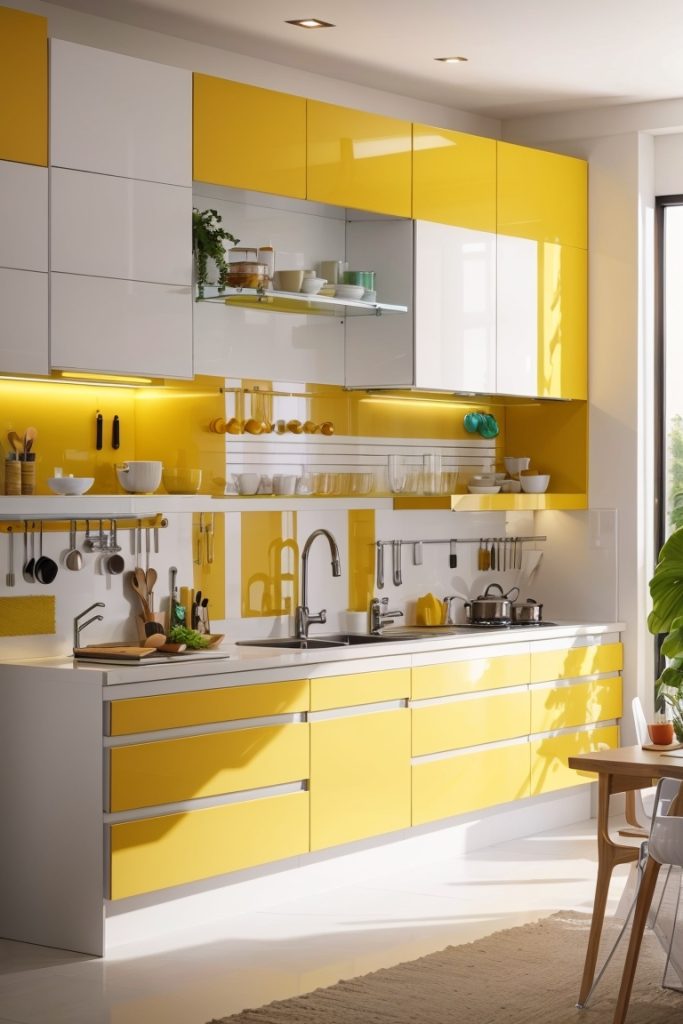
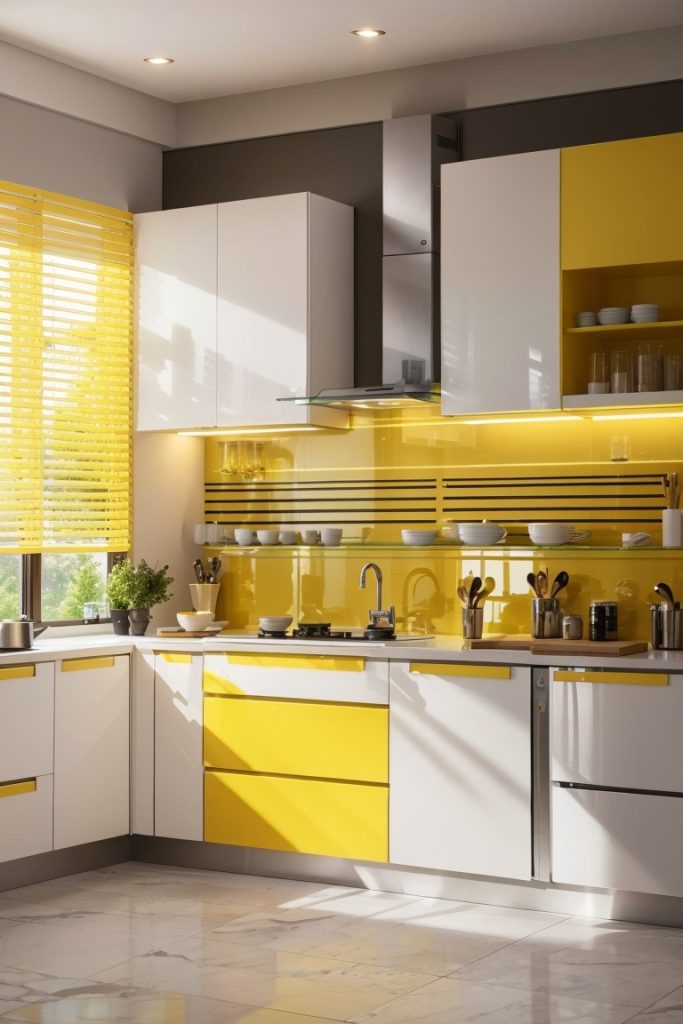

What Kinds of Materials Are Used in Kitchen Cabinets?
- MDF (Medium-Density Fiberboard): MDF is a popular option for kitchen cabinets due to its affordability and versatility. It is made from microscopic wooden fibers cemented together using resins and hot-pressed to form a smooth and dense sheet. MDF provides a uniform texture without knots or blemishes, making it aesthetically appealing for various design styles, including traditional kitchen appearances.
Despite its cost-effectiveness, MDF exhibits exceptional durability and strength, making it a reliable choice for kitchen cabinets that can endure frequent usage. It provides a smooth and level surface, making it ideal for various finishes and laminates, including matte, glossy, or textured laminates.
- HDF-HMR (High-Density Fiberboard High Moisture-Resistance): HDF-HMR is an advanced and superior material known for its exceptional strength and resistance to moisture. It is a variant of HDF (High-Density Fiberboard) produced by compressing timber fibers with high pressure and specialized resins. The addition of moisture-resistant properties makes HDF-HMR particularly well-suited for areas with high water exposure, such as the kitchen and lavatory.
HDF-HMR offers several advantages:
- Improved Moisture Resistance: HDF-HMR is specifically designed to manage moisture, making it highly resistant to water damage. This characteristic is vital in areas like the kitchen, where water spillage, humidity, and moisture are common occurrences.
- Extremely Robust and Long-lasting: HDF-HMR can withstand the rigors of daily utilization in high-traffic areas due to its solid composition and strong resistance to moisture, ensuring a long longevity for your kitchen cabinets and restroom units.
- Screw Holding Capacity: HDF-HMR has an exceptional screw holding capacity, ensuring that screws and fittings remain securely in position over time, making it ideal for constructing dependable and durable modular kitchen cabinets.
- Optimal for Carcass Construction: Due to its strength and stability, HDF-HMR is frequently utilized as the primary material for the carcass or internal framework of modular kitchen cabinets.
- Excellent for Paneling: HDF-HMR can be precisely molded and curved, enabling complex and attractive design components. Panels with grooves or patterns function particularly well with HDF-HMR.
- Resistance to Swelling and Warping: HDF-HMR’s moisture-resistant characteristics make it less likely to expand or distort when exposed to moisture or variations in humidity, ensuring that your kitchen cabinets maintain their shape and usefulness over time.
- Simple Cleaning and Maintenance: HDF-HMR is simple to clean and maintain. A damp cloth can be used to wipe it down, and regular cleansing will help maintain its appearance and functionality.
Estate Lookup Interiors employs HDF-HMR for the rear panels of all products, including kitchen cabinets, wardrobes, and storage units, to ensure their durability and long-lasting performance, even in demanding environments like the kitchen.

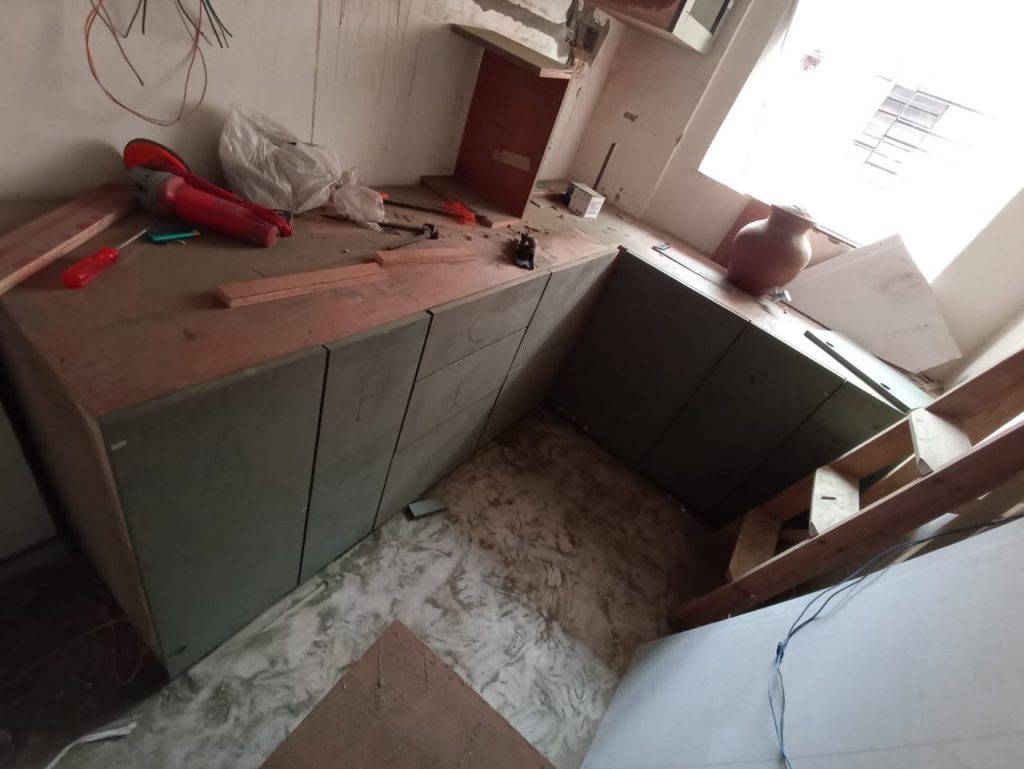

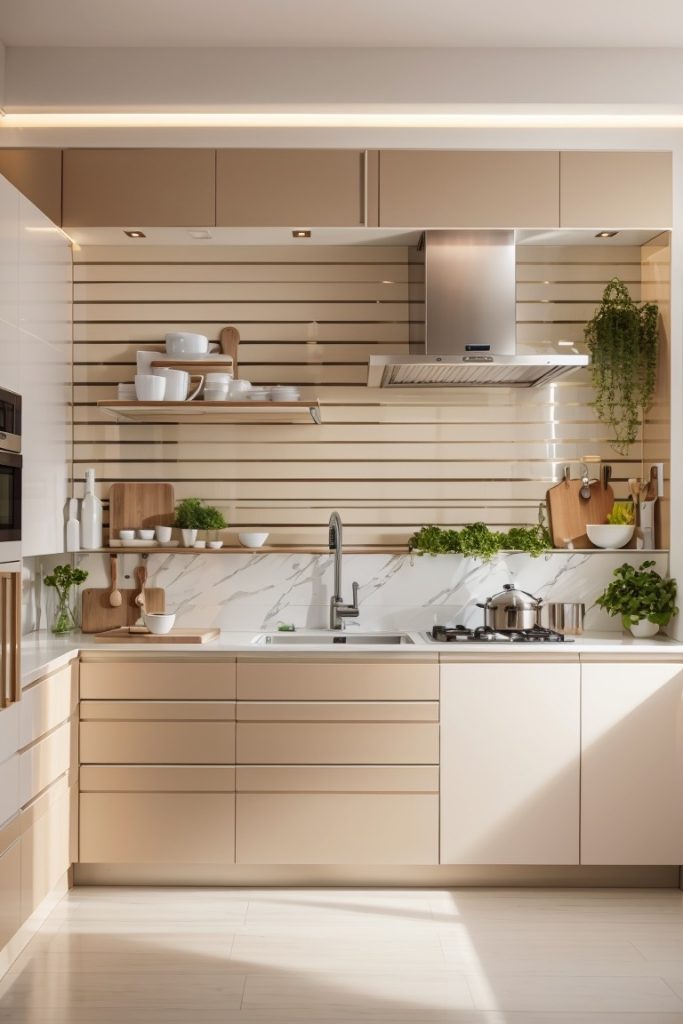

- Plywood:
Due to its strength and stability, plywood is a very long-lasting and adaptable material that is frequently used for kitchen cabinets. Strong adhesives are used to join layers of thin veneer sheets that have been layered perpendicularly to create this engineered wood. Plywood‘s exceptional strength and resistance to warping or breaking come from this cross-grain composition.
Plywood’s resistance to moisture is one of its main benefits, making it ideal for kitchen settings where water exposure is frequent. The most common alternatives for kitchen cabinets among the several varieties of plywood are BWR (Boiling Water-Resistant) and BWP (Boiling Waterproof).
BWR Plywood (Boiling Water-Resistant): To increase its moisture resistance, BWR plywood is given a unique chemical treatment. It can tolerate being submerged in water for up to 8 hours without suffering any serious harm. Kitchen counters and locations below sink units that may come into touch with water are good places for BWR plywood.
BWP Plywood (Boiling Waterproof): The best grade of waterproof plywood is BWP plywood. It is particularly made to withstand water for a long time and can withstand moisture for up to 72 hours. For kitchens in locations prone to regular water spills or flooding, BWP plywood is a great option.
Keep in mind that plywood is heavier than materials like MDF or HDF-HMR when utilizing it for kitchen cabinets. As a result, it is not advised to use it in cabinet shutters since the extra weight might eventually cause them to dislodge or droop.
Due to its longevity and resistance to moisture, plywood is a desirable material for kitchen cabinet carcasses. Carcasses, which serve as the body to which shutters, fasteners, and hinges are attached, comprise the structural structure of the modules. The carcasses of the modular kitchen are built on a solid basis thanks to the use of plywood.
When selecting plywood for kitchen cabinets, it is crucial to take into account the particular requirements of your kitchen. To ensure the durability and functionality of your kitchen cabinets, use BWR or BWP plywood if you live in a region with high humidity or a history of water-related disasters.
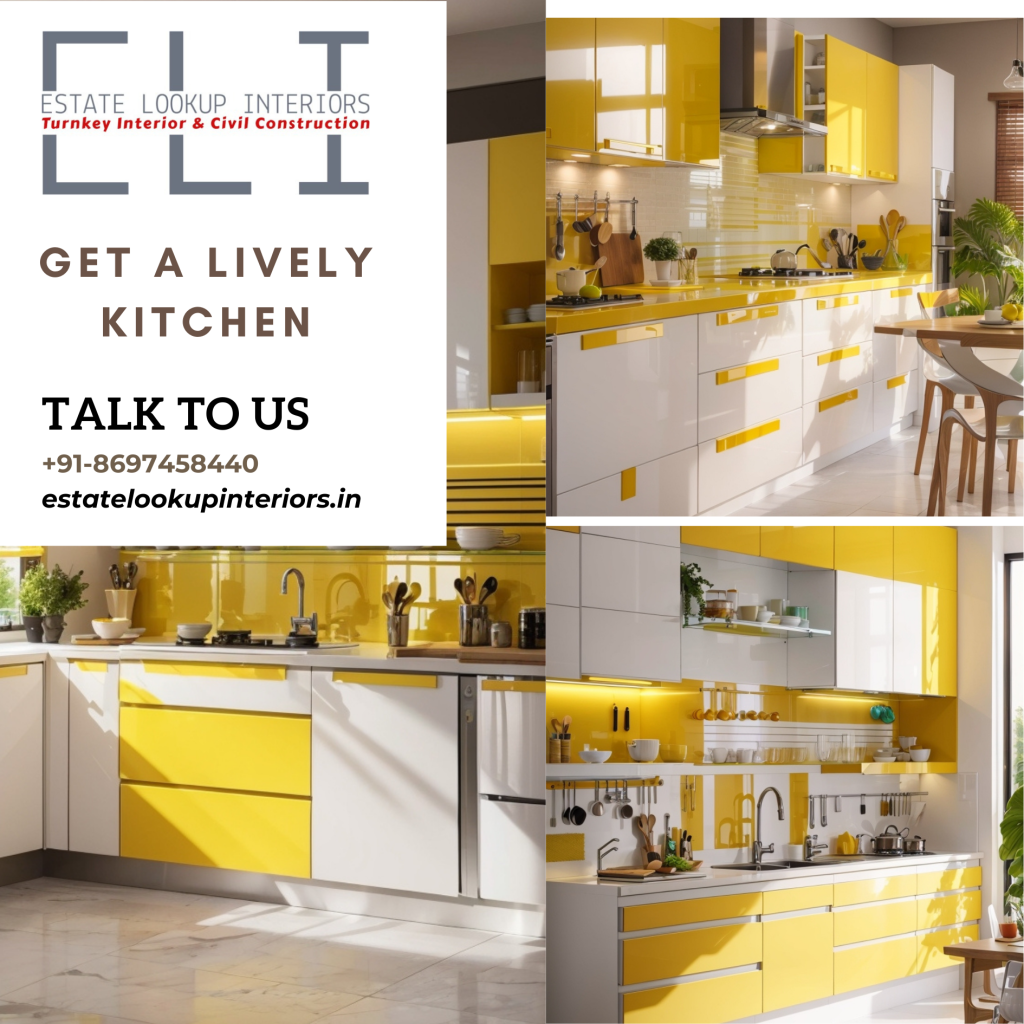
- Solid Wood: Although robust, solid wood is not recommended as the base material for kitchen cabinets due to its propensity to expand or deform when exposed to moisture.
- Particle Board: Particle board is a cost-saving option used in furniture and cabinetry, including kitchen cabinets. However, it is not as robust and durable as HDF-HMR or MDF, making it less suitable for areas with high moisture or intensive use.
While particle board can be used for cabinets in locations with budget restrictions and where there is minimal moisture exposure, it is advisable to use materials like HDF-HMR or MDF for essential kitchen areas that are susceptible to moisture.
- PVC (Polyvinyl Chloride): PVC is a synthetic plastic material frequently used in various applications, including kitchen cabinets. It is a low-cost option with straightforward maintenance, making it suitable for some situations. However, there are limitations and disadvantages to using PVC in an active and humid environment like the kitchen:
- Not as Sturdy: PVC is not as durable as materials like plywood or HDF-HMR, making it less suitable for severe utilization or weight-bearing, particularly in busy kitchens with frequent door openings and closings.
- Heat Sensitivity: PVC is sensitive to high temperatures and may warp or distort in the presence of extreme heat, making it unsuitable for use close to furnaces or cookers.
- Limited Aesthetics: PVC may not have the same natural beauty and richness as materials like wood or veneer, making it a less preferred option for householders seeking a more opulent or sophisticated appearance for their kitchen cabinets.
While PVC can be a low-cost and easy-to-maintain option for kitchen cabinets in some instances, it may not be the best choice for an active and humid area like the kitchen. Materials like HDF-HMR or plywood would be more preferable for long-term performance and aesthetics.
- Stainless Steel: Stainless steel is appreciated and well-suited for commercial kitchens due to its durability, impervious properties, ease of cleansing, heat resistance, and modern aesthetics. Stainless steel is known for its exceptional strength, making it ideal for kitchen cabinets in active commercial environments. It is inherently water and moisture resistant, ensuring that it maintains its structural integrity even after protracted contact with liquids.
Stainless steel surfaces are smooth and non-porous, making them simple to clean and maintain in commercial kitchens, where hygiene and sanitation are crucial. Additionally, stainless steel’s resistance to heat and fire makes it suitable for use near culinary appliances and furnaces.
In conclusion, stainless steel is a resilient, impermeable, and antiseptic material that excels in commercial kitchen settings. Its durability, moisture resistance, and modern aesthetics make it an ideal choice for maintaining a safe, clean, and efficient working environment in busy commercial kitchens.
To finalize your decision, select the material that best suits your demands and budget, and add the ideal kitchen finish to it. Estate Lookup Interiors offers top-notch kitchen interiors with quality and assurance. Whether you need reputable interior designers in Kolkata or the finest interior designers nearby, Estate Lookup Interiors is here to assist.
FAQs:
- What Kind of Material Should Be Used for Modular Kitchen Cabinets?
A combination of plywood, HDF-HMR, and plywood works best for durable and high-quality kitchen cabinets. HDF-HMR is an excellent choice as it is denser, but it may be marginally more expensive than plywood. - What Kind of Material Do Kitchen Cabinets Usually Come In?
Plywood is commonly used for the carcasses of kitchen cabinetry, while laminate is used for embellishments. - Does MDF Outperform Solid Wood or Plywood for making Modular Kitchen ?
MDF is more cost-effective and environmentally favorable compared to solid timber or plywood. However, substantial timber is more durable. - What Benefits Can Plywood Offer for Modular Kitchen Cabinets?
Plywood is exceedingly strong and durable, resistant to water, and allows for simple customization with a smooth and level surface. - Why are HDF-HMR Kitchen Cabinets a Great Option?
HDF-HMR offers enhanced moisture resistance, exceptional strength, fastener holding capacity, and is optimal for carcass construction and paneling. It is an ideal choice for kitchen cabinets that need to withstand moisture and extensive utilization. - How Do MDF Modular Kitchen Cabinets Compare to Solid Wood?
MDF is a more affordable, smoother, and versatile alternative to solid wood, offering a variety of design options for kitchen cabinets. - Why is Stainless Steel Suitable for Commercial Kitchens?
Stainless steel is durable, waterproof, simple to clean, heat-resistant, and offers a modern aesthetic, making it an ideal choice for kitchen cabinets in busy commercial environments. Its hygienic properties also make it suitable for food preparation environments.
